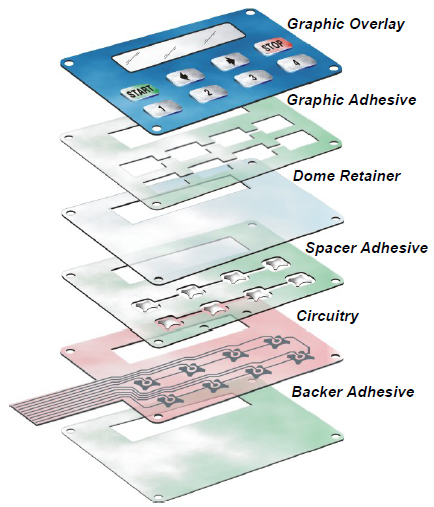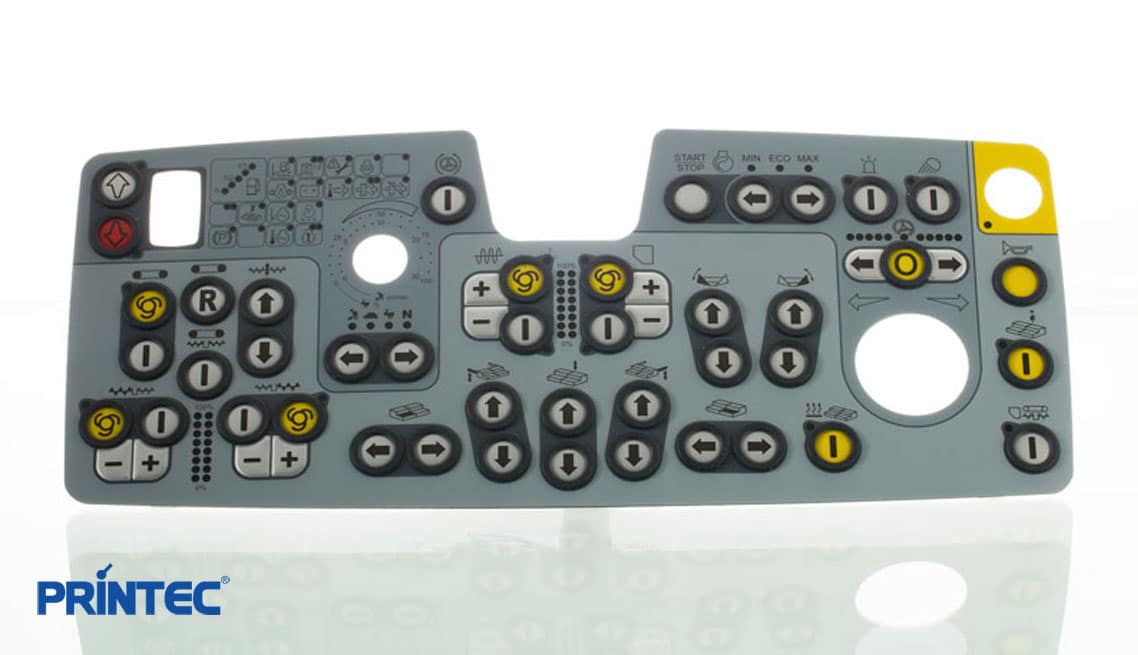It’s important to review the capabilities of any membrane switch manufacturer before starting a project.
It’s important to review the capabilities of any membrane switch manufacturer before starting a project.
Blog Article
Everything About Membrane Layer Switch Over: Comprehending Its Layout and Functionality
When you consider the control interfaces in modern-day devices, membrane switches often come to mind. These parts are extra than simply buttons; they mix layout and performance effortlessly. Comprehending how they function and what makes them efficient can change your viewpoint on day-to-day electronic devices. But, there are nuances to their layout and efficiency that you could not understand. Allow's explore what collections membrane layer switches over in addition to various other control systems.
What Are Membrane Buttons?

Membrane switches can also be customized regarding form, size, and graphics, allowing suppliers to create one-of-a-kind user interfaces customized to particular products. Generally, membrane buttons play a significant duty in improving individual experience across a large array of applications.
How Membrane Switches Over Work
When you push a secret on a membrane button, it turns on a simple yet effective device. The top layer, frequently constructed from adaptable product, pushes down onto a conductive layer underneath it. This action bridges the space in between conductive traces, finishing an electrical circuit. As quickly as the circuit closes, it sends a signal to the device's controller, which translates your input.
You'll see that the responsive feedback varies based on the button design, offering either a soft click or a more pronounced action. Once you release the secret, the membrane go back to its original placement, reopening the circuit and quiting the signal. This procedure happens virtually instantaneously, ensuring a responsive individual experience.
Membrane layer switches are preferred because of their durability and resistance to dirt and wetness, making them ideal for various applications, from household home appliances to medical gadgets. Recognizing this procedure aids you value their widespread use.
Key Parts of Membrane Buttons
Understanding the crucial components of membrane layer buttons is essential for understanding their functionality and style. The protective layer guards versus environmental factors and put on, prolonging the button's life-span. By recognizing these elements, you'll gain understanding right into just how membrane layer changes run and their importance in numerous applications.
Materials Made Use Of in Membrane Layer Switch Style
The performance and toughness of membrane switches over heavily rely on the materials utilized in their style. You typically run into polyester and polycarbonate as main substratums due to their exceptional toughness and flexibility. These products stand up to scrapes and chemicals, making them ideal for requiring settings.
The conductive layers typically make use of silver or carbon, chosen for their integrity and conductivity. membrane switch manufacturer. Silver supplies premium performance, while carbon is a cost-effective choice. For the overlay, you could take into consideration a matte or shiny surface, depending upon your aesthetic requirements and individual experience
Adhesives play an important role also; they bond layers safely and ensure long life. Make sure to pick adhesives that hold up against environmental variables like temperature level and moisture. Lastly, don't overlook the importance of an excellent printing technique for graphics, as it improves both capability and aesthetic appeal. Selecting the ideal materials will certainly assure your membrane layer switch stands the examination of time.
Style Considerations for Membrane Switches
While designing membrane switches, it's vital to take right into account different elements that affect their performance and customer experience. Beginning by concentrating on the format and button dimension; make specific they're intuitive and very easy to navigate.
Confirm your design accommodates ecological aspects, like dampness or temperature variants, which could influence performance. By very carefully taking into consideration these components, you'll develop a membrane switch that boosts functionality and contentment.
Applications of Membrane Layer Buttons
Membrane buttons are functional parts found in different applications, from commercial equipment to customer electronics. You'll see their impact in makers that need long lasting user interfaces and in devices that take advantage of streamlined designs. Recognizing these applications assists you value the capability and usefulness of membrane switches in day-to-day modern technology.
Industrial Devices Use
When you're looking to boost the functionality of commercial equipment, membrane layer switches offer a reputable service that integrates toughness with easy to use style. These buttons are ideal for extreme atmospheres, supplying resistance to dust, wetness, and chemicals. Accept membrane switches to simplify your procedures read and enhance why not look here overall performance.
Customer Electronic Devices Combination
In the domain of customer electronics, membrane buttons play an important function in boosting user interaction and device performance. You'll locate them in devices like microwaves, remotes, and gaming consoles, offering a seamless way to connect with modern technology. Their streamlined design enables simple combination into different products, making controls user-friendly and user-friendly. With their capacity to include graphics and backlighting, you can take pleasure in a modern visual that enhances the tool's overall look. Membrane switches additionally guarantee longevity and resistance to dirt and moisture, expanding the life-span of your electronic devices. By picking membrane buttons, you improve not simply the capability yet additionally the style of your gadgets, making everyday interactions smooth and delightful.
Advantages and Downsides of Membrane Layer Buttons
While membrane layer buttons use a range of advantages, they also come with some disadvantages that you should consider. One substantial advantage is their compact layout, making them ideal for space-constrained applications.

Nonetheless, there are disadvantages. Membrane original site switches can have a shorter lifespan compared to mechanical switches, specifically under heavy use. They can also be much less responsive, which may affect customer feedback during operation. If harmed, repairing them can be difficult and often requires total substitute. Inevitably, their level of sensitivity to severe temperatures and environmental problems might limit their effectiveness in certain setups. Balancing these pros and disadvantages will certainly help you figure out if membrane buttons are the appropriate fit for your project.
Frequently Asked Concerns
For How Long Do Membrane Switches Generally Last?
Membrane layer changes generally last in between 5 to one decade, depending upon usage and ecological conditions. You'll want to review aspects like wear, exposure to wetness, and temperature level changes to assess their durability effectively.
Can Membrane Switches Be Custom-made for Specific Layouts?
Yes, you can customize membrane layer switches to fit particular styles (membrane switch manufacturer). You'll have the liberty to select colors, forms, and formats that match your project's needs, guaranteeing they blend seamlessly with your total visual
What Is the Cost Array for Membrane Layer Change Production?
The expense range for membrane layer button manufacturing generally falls in between $1 and $10 per device, depending on aspects like design complexity, quantity, and products. You can obtain quotes from producers to locate the most effective choice.

Are Membrane Changes Waterproof or Immune?
Membrane switches can be developed to be water-proof or immune, depending upon products utilized and construction techniques. If you require them for wet environments, ensure you specify those needs during the style procedure.
How Do Membrane Switches Contrast to Traditional Switches?
Membrane buttons are generally thinner and extra versatile than conventional buttons, offering a sleek style. They're frequently simpler to cleanse and integrate, however could not give the responsive comments you're utilized to with mechanical choices.
Final thought

Report this page